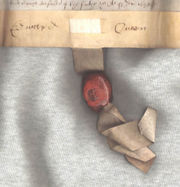
Sigillography
Encyclopedia

Auxiliary sciences of history
Auxiliary sciences of history are scholarly disciplines which help evaluate and use historical sources and are seen as auxiliary for historical research...
. It refers to the study of seals
Seal (device)
A seal can be a figure impressed in wax, clay, or some other medium, or embossed on paper, with the purpose of authenticating a document ; but the term can also mean the device for making such impressions, being essentially a mould with the mirror image of the design carved in sunken- relief or...
attached to document
Document
The term document has multiple meanings in ordinary language and in scholarship. WordNet 3.1. lists four meanings :* document, written document, papers...
s as a source of historical information. It concentrates on the legal and social meaning of seals, as well as the evolution of their design. It has links to diplomatics
Diplomatics
Diplomatics , or Diplomatic , is the study that revolves around documentation. It is a study that focuses on the analysis of document creation, its inner constitutions and form, the means of transmitting information, and the relationship documented facts have with their creator...
, heraldry
Heraldry
Heraldry is the profession, study, or art of creating, granting, and blazoning arms and ruling on questions of rank or protocol, as exercised by an officer of arms. Heraldry comes from Anglo-Norman herald, from the Germanic compound harja-waldaz, "army commander"...
, social history
Social history
Social history, often called the new social history, is a branch of History that includes history of ordinary people and their strategies of coping with life. In its "golden age" it was a major growth field in the 1960s and 1970s among scholars, and still is well represented in history departments...
, and the history of art
Art history
Art history has historically been understood as the academic study of objects of art in their historical development and stylistic contexts, i.e. genre, design, format, and style...
.
Antiquaries
Antiquarian
An antiquarian or antiquary is an aficionado or student of antiquities or things of the past. More specifically, the term is used for those who study history with particular attention to ancient objects of art or science, archaeological and historic sites, or historic archives and manuscripts...
began to record historic seals in the 15th century, and in the 16th and 17th centuries their study became a fairly widespread antiquarian activity. The term sigillography is first found in the works of Jean Mabillon
Jean Mabillon
Jean Mabillon was a French Benedictine monk and scholar, considered the founder of palaeography and diplomatics.-Early career:...
in the late 17th century, and in those of Johann Michael Heineccius
Johann Michael Heineccius
Johann Michael Heineccius was a well-known German preacher and theologian, the brother of Johann Gottlieb Heineccius. He was born in Eisenberg, Thuringia....
soon afterwards. Initially thought as a branch of diplomatics
Diplomatics
Diplomatics , or Diplomatic , is the study that revolves around documentation. It is a study that focuses on the analysis of document creation, its inner constitutions and form, the means of transmitting information, and the relationship documented facts have with their creator...
, the discipline gradually became an independent branch of historical studies.
In the second half of the 19th century sigillography was further developed by German and French historians, among them Hermann Grotefend, Otto Posse, Louis-Claude Douet d'Arcq and Germain Demay.
Sigillography is also an important subdiscipline of Byzantine studies
Byzantine studies
Byzantine studies is an interdisciplinary branch of the humanities that addresses the history, culture, costumes, religion, art, such as literature and music, science, economy, and politics of the Byzantine Empire. The discipline's founder in Germany is considered to be the philologist Hieronymus...
, involving the study of Byzantine lead seal impressions and the text and images thereon. Its importance derives from both the scarcity of surviving Byzantine documents themselves, and from the large number (over 40,000) of extant seals. One of the largest compendiums of Byzantine seals can be found in the large-volume by Gustave Schlumberger, "Sigillographie de l'empire Byzantin," published in 1904.
Sigillography in Popular Culture
Sigillography features in the plot of "King Ottokar's SceptreKing Ottokar's Sceptre
King Ottokar's Sceptre is the eighth of The Adventures of Tintin, a series of classic comic-strip albums, written and illustrated by Belgian writer and illustrator Hergé, featuring the young reporter Tintin. It was first serialized as a black-and-white comic strip in Le Petit Vingtième on 4 August...
", one of The Adventures of Tintin
The Adventures of Tintin
The Adventures of Tintin is a series of classic comic books created by Belgian artist , who wrote under the pen name of Hergé...
.

